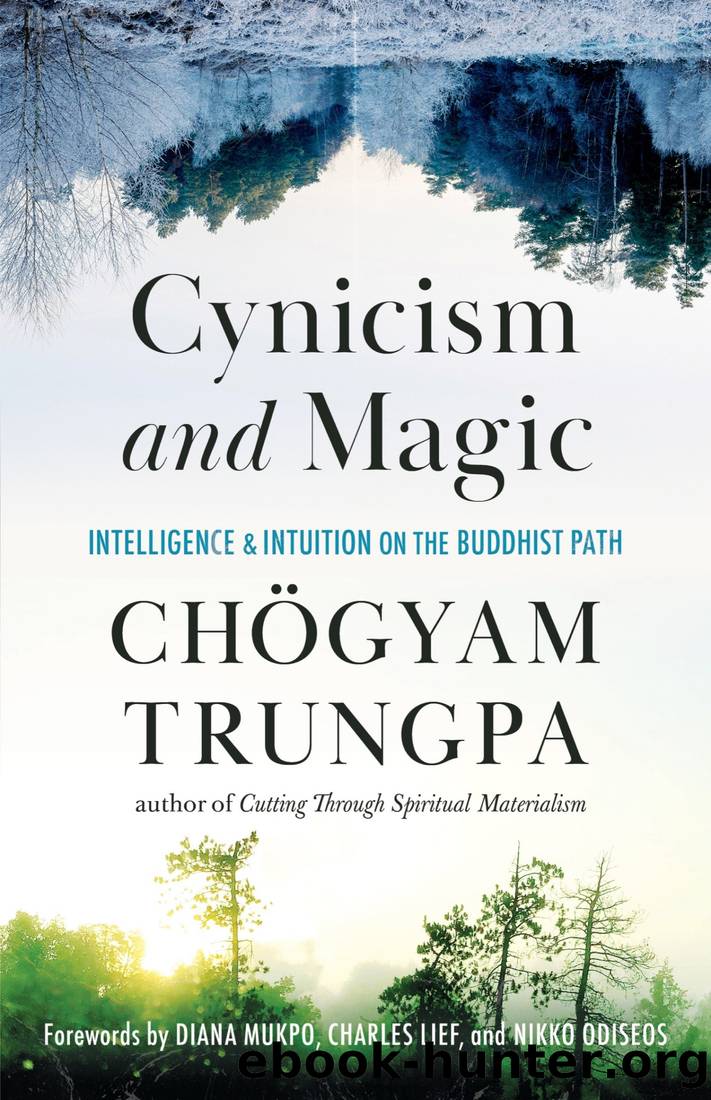Cynicism and Magic: Intelligence and Intuition on the Buddhist Path by Chogyam Trungpa

Author:Chogyam Trungpa [Trungpa, Chogyam]
Language: eng
Format: epub
Tags: Religion, buddhism, Rituals & Practice, Tibetan
ISBN: 9781611808094
Google: Cyc5EAAAQBAJ
Publisher: Shambhala Publications, Incorporated
Published: 2021-11-15T23:40:50.065521+00:00
Skip Notes
*1Samadhi (Skt.: âbring togetherâ) is variously defined as âtotal involvement,â âconcentration,â or âmeditative absorption.â
*2Seventh bhumi: the stage where a bodhisattva engages in skillful means.
7
Borrowing the Buddhaâs Heart
⢠⢠â¢
THE GOOD NEWS is that it is possible to attain enlightenment. It is possibleâitâs not just a hypothetical concept. The dynamite exists to create an enormous spark of energy. We may be able to experience the heart of the teachings, directly, precisely, and thoroughly, rather than trying to get into the millions of the Buddhaâs teachings, or sutras, which would be like trying to swim the ocean, with no idea where the shore is.
The bodhisattva path becomes extremely important at this point, because it captures all the principles that Buddha taught and brings them into an inspiring and workable living situation. Coming out of hinayana discipline, you begin to raise your consciousnessâor you could say inspiration, pride, or faithâ and you develop a sense of hope. This particular hope is not ego reinforcement, but rather the hope of losing ego. Thereâs a willingness to jump into the pattern of the teachings. A new openness happens, along with an enormous irony: you are unable to distinguish whether you are treading on the path, or you are the path itself. You lose your reference point. Sometimes you feel youâre on the path. Other times you find you are simultaneously the path and the traveler. There is a lot of humor in that.
Up until now, your hinayana inspiration left you with a strong impression that there was no other way than the strictness and narrowness of your discipline, which was very simple and direct, without any preconceptions, any particular color or fantasy. The hinayana is just the direct discipline of working with the practice of shamatha and vipashyana, and knowing the nature of reality as the Buddha presented, in terms of the three marks of existence.
At this point you begin to lift your head, to stick your neck out slightly more. So far you have been bowing your head to see the texture of the path. Now you raise your head a little bit and begin to see thereâs a horizon, a meeting point of earth and sky. You also see that you deserve to see, and are capable, so itâs pretty certain that you will walk beautifully and precisely without stumbling on the path. You develop a new kind of genius: you can walk and look far at the same time, which is a fantastic thing. It means that you have expanded your consciousness to the mahayana path of openness, complete openness, which is extremely powerful, and very real at the same time.
You can now commit yourself to the bodhisattva path. The way the sutras describe it, a would-be bodhisattva, or student of mahayana discipline, transplants a new heart into him- or herself. You might ask, âFrom where am I transplanting this particular heart?â It is from the inspiration and experience of genuine discipline. You are not trying to kid yourself, or amuse yourself.
Download
This site does not store any files on its server. We only index and link to content provided by other sites. Please contact the content providers to delete copyright contents if any and email us, we'll remove relevant links or contents immediately.
| Anthropology | Archaeology |
| Philosophy | Politics & Government |
| Social Sciences | Sociology |
| Women's Studies |
Born to Run: by Christopher McDougall(6899)
The Leavers by Lisa Ko(6808)
iGen by Jean M. Twenge(5168)
Sapiens by Yuval Noah Harari(5128)
The Kite Runner by Khaled Hosseini(4960)
Spare by Prince Harry The Duke of Sussex(4804)
Bullshit Jobs by David Graeber(3847)
Machine Learning at Scale with H2O by Gregory Keys | David Whiting(3660)
Never by Ken Follett(3549)
Livewired by David Eagleman(3537)
Goodbye Paradise(3460)
Fairy Tale by Stephen King(2971)
A Dictionary of Sociology by Unknown(2862)
Harry Potter 4 - Harry Potter and The Goblet of Fire by J.K.Rowling(2816)
The Social Psychology of Inequality by Unknown(2774)
The Club by A.L. Brooks(2756)
People of the Earth: An Introduction to World Prehistory by Dr. Brian Fagan & Nadia Durrani(2620)
0041152001443424520 .pdf by Unknown(2608)
Will by Will Smith(2593)
